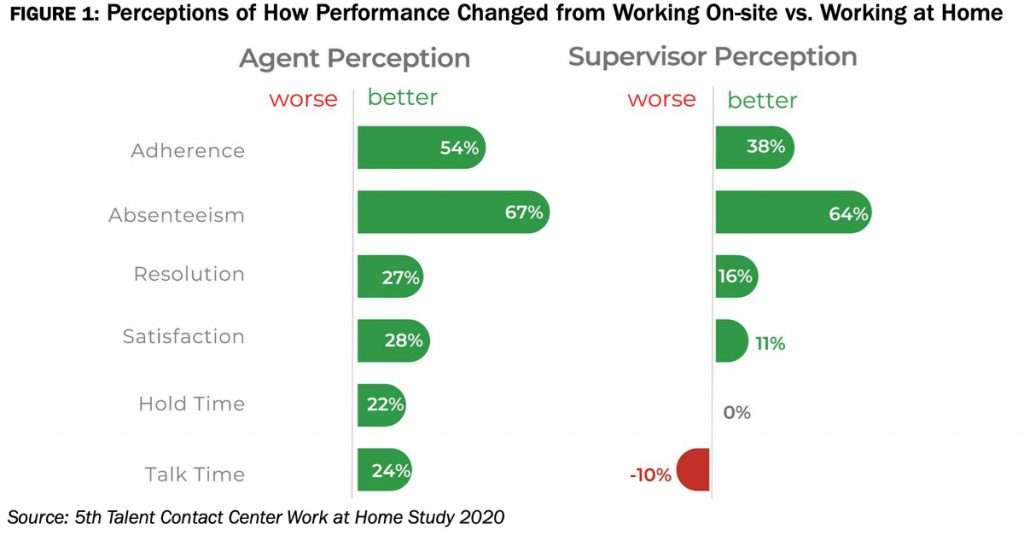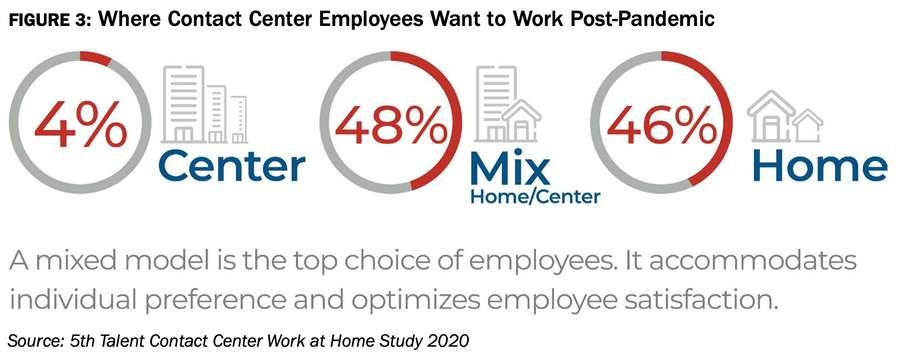
The COVID-19 pandemic has led to a rapid and global shift of moving contact center agents and supervisors to a work-at-home model, giving rise to two central questions: How has this impacted performance; and is the traditional work-at-home model sustainable? Common industry wisdom favors a 100% work-at-home model as the best chance for sustainability, and that most of the agents who performed well in the center will not transition successfully to working at home. If only certain agents can excel working at home, then it seems that the only choice is to replace those agents who excelled in the center with those who are more suited to the challenges of the work-at-home model. This is a costly and potentially overwhelming challenge for most organizations.
To investigate these real concerns, in May 2020, 5th Talent International delivered a survey to more than 4,000 agents and supervisors across seven countries. The findings provide unexpected insight into the point of view of the work-at-home employee and suggests that there are more efficient and effective ways to successfully transition to and sustain a work-at-home model. However, it requires moving away from a strategy of changing your agents to fit your model, and instead, changing your model to fit the needs of your agents.
Work-at-Home Performance
According to a large majority of participants, their performance across six key performance indicators was the same or better at home than when working in the contact center. (See Figure 1.) This provides evidence that success can transfer from the center to the home. It is understandable that adherence and absenteeism would improve with less complications from such things as commuting. However, the rise in customer satisfaction and resolution is less easy to explain. Analysis of employees’ comments may provide some key insights. Employees indicated that they feel less stress at home, find it easier to concentrate, do not feel as though someone is constantly looking over their shoulder, and can be more themselves with customers.
Agent Work-at-Home Likes and Dislikes
There are many benefits to an at-home model for agents and survey participants indicated that the top considerations are avoiding a commute, saving money, more time with family and less stress overall.
After the pandemic, if agents are asked to return to the center 100% of the time, the loss of these benefits could negatively impact employee satisfaction and turnover. However, money and work-life balance traditionally are not the key reasons why people stay in their jobs. In other words, the top benefits of working at home are not likely to sustain employee satisfaction long-term. What agents liked least was largely related to technology. Topping the list of dislikes were internet/power issues, lack of support from the IT department, lack of support with customers and challenges with tools/equipment. It is not surprising that these were the top reported issues since many companies (and the internet) were not prepared to support the sudden massive move of employees to their homes.
Challenges with Working at Home
In addition to dislikes, employees identified several challenges that they are experiencing at home. Among the top cited challenges were that it requires more effort to work with each other and customers, feelings of loneliness, and growing frustration with impersonal, computer-based communication.
Though agents indicated a rise in effort working with customers after moving to a work-at-home model, they also suggested that they are experiencing an increase in effort working with their supervisors. More concerning is that the largest source of elevated effort is supervisors working with their teams, suggesting that supervisors are more impacted by the move to working at home than others in the organization. (See Figure 2.) More effort requires more time, which means you have less time to do other things, like building relationships between supervisors and agents. Employees attribute the loss of in-person communications as the major reason for the increase in effort. Companies that have not overcome this problem will soon be feeling the fatigue of the at-home model. This will begin to impact employee satisfaction, engagement and performance.
Another area of concern is the increased feelings of loneliness reported by employees. Approximately 17% of employees feel a sense of loneliness, and 72% of them believe it impacts their happiness at work. The top three reasons given for this increase in loneliness are missing face-to-face contact with co-workers, loss of informal communications with others, and lack of emotional support of co-workers. Generation Z employees are twice as likely to be lonely than other generations. This is particularly concerning since the fastest-growing employee base is those who are 25 years old or younger. Loneliness is another issue that, if not mitigated, will grow over time.
Where Employees Want to Work
When asked where they want to work, the top choice is a mix of splitting their time between home and the contact center. Less than half of the employees surveyed want to work entirely at home. Respondents indicated that by having the option for occasional face-to-face interactions, they realize the benefits from both working at home and in the center.
Surprisingly, after the pandemic, only 4% of employees say they want to return to only working in a center. (See Figure 3.) An analysis of comments revealed that COVID-19 had little influence on their future work arrangement preference with only 8% of comments mentioning the pandemic. There was no significant difference in work arrangement preference that could be identified by the country they live in. It does appear that the size of the city they live in makes a difference, likely due to the commuting challenges.
Change Your People or Change Your Model?
It is true that some agents are more resistant to a traditional work-at-home model. Agents who are more experienced, self-managing and self-motivated can better adapt to the increased effort, communication challenges and loneliness of working at home. However, many believe that the majority of employees who have been successful in the center cannot transition their success to working at home. We disagree. Who is at fault if they are not successful at home? Does the responsibility fall on the company and its support of their agents, or on the agents themselves?
We believe that the answer to long-term sustainability is to build a model that effectively supports your agents rather than replaces your agents. The supervisor is the foundation of success for the work-at-home model. (See Figure 4.)
Supervisor Role Is the Key to Successful, Sustainable WAH Model
The results of the study are clear. Supervisors, more than agents, struggle with making the transition to working at home. This is because supervisors have two challenges to overcome: They also must adapt to the new work arrangement, and they must help individual team members successfully transition, as well. It takes a mindset shift and new skills to rise to these challenges.
Supervisors who have proven to be more successful in a work-from-home model are those who adopt more of a “life coach” role vs. a command-and-control leadership style. As life coach, they strive to help their team members to be competent in their job, focused on the task at hand, and connected socially to others at work and around them at home. Those who are competent, focused and connected are more likely to excel—and are more likely then to become life coaches for others, perpetuating the success of the work-at-home model.
A Mixed Model Provides the Most Benefits
Another opportunity to improve the work-at-home sustainability is to implement a mixed model. A model that allows employees to split their time between home and center provides most of the benefits and reduces most of the negative factors of both work arrangements. This model is the top choice of employees because it accommodates individual preferences and optimizes employee satisfaction. Since most employees want to spend most of their time at home in a mixed model, companies can significantly reduce their contact center capacity, and potentially replace a single center with multiple microsites. 5th Talent believes a “work where you want” model will emerge which allows agents to manage and schedule how often they want to work at home and in the center. (See Figure 5.) This helps employees to become more self-managing which increases satisfaction, engagement, performance and retention.
Survey Employees to Determine What They Want
Surveying your employees is the most effective way to gain a better understanding of what type of work environment your employees want, as well as their challenges and motivators. To create a best-fit work-from-home model, we recommend that organizations survey employees at each location.
For a limited time, Contact Center Pipeline readers can use the 5th Talent Work-at-Home Questionnaire to survey your agents and supervisors. There is no cost to use the questionnaire, and you can benchmark your results against the report.
To access the survey questionnaire, visit: https://www.5thtalent.com/use-our-survey
To benchmark your results, download a copy of the 5th Talent Contact Center Work at Home Industry Study 2020
5th Talent International is a service consulting company that helps organizations develop a meaningful work environment, which significantly lowers turnover and increases customer satisfaction. Learn more about our methodology at www.5thtalent.com.










